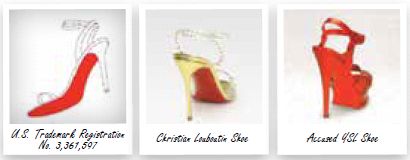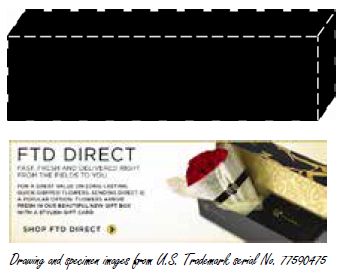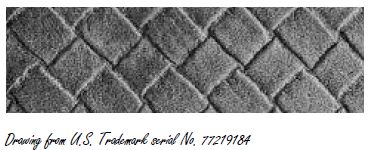The doctrine of aesthetic functionality was revived in the recent Louboutin case to protect the competitive need to use color to communicate a particular message. In that case, Christian Louboutin S.A. tried to enforce its trademarked red lacquered outsole against Yves Saint Laurent's use of the color red on a monochromatic shoe (including on the outsole). Christian Louboutin S.A. v. Yves Saint Laurent America, Inc., 778 F. Supp. 2d 445, 447-48 (S.D.N.Y. 2011). The district court relied on Qualitex, finding that color would only be protectable if it distinguishes one's goods and identifies their source, without serving a function. Qualitex Co. v. Jacobson Prods. Co., 514 U.S. 159, 162 (1995). It accordingly held that Louboutin's red outsole served non-trademark functions, such as eluding energy and sexiness, and could not be upheld as a trademark as it would hinder creativity and artistic freedom in the fashion industry to preclude competitors from using the color on shoes.

The U.S. Court of Appeals for the Second Circuit reversed the district court's decision. It noted that to uphold the district court's decision would be to single out the fashion industry and hold it to a different standard than other industries. It reviewed Louboutin's evidence of acquired distinctiveness of the mark and determined that it had little support for acquired distinctiveness extending to uses where the red outsole did not contrast with the upper portion of the shoe (e.g., monochromatic shoe like that of YSL). Thus, it held that Louboutin's red outsole is entitled to limited protection as a trademark. Christian Louboutin S.A. v. Yves Saint Laurent America Holding, Inc., 696 F.3d 206 (2d Cir. 2012). This protection amounts to a limitation of the red outsole registration to situations where the red outsole contrasts in color with the upper portion of the shoe.
This was seen as a win for the fashion industry as well as for both parties. The fashion industry was allowed once again to protect single colors as trademarks. As for the parties, Louboutin viewed it as validation of its trademark albeit in limited circumstances, and YSL interpreted it as a win because it was allowed to continue to use red soles on monochromatic red shoes. The decision also provided a test for aesthetic functionality. The decision held that a mark is aesthetically functional and therefore ineligible for trademark protection if: (1) the design feature is essential to the purpose of the good; (2) the design feature affects the cost or quality of the product; and (3) protection of the design feature would significantly hinder competition.
In 2013, the Trademark Trial and Appeal Board addressed the issue of aesthetic functionality and provided some guidance into the "competitive need" factor in two noteworthy cases. In the first case, Florists' Transworld Delivery (FTD) attempted to register the color black for packaging for its flower arrangements. In re Florists' Transworld Delivery, Inc., 106 USPQ2d 1784 (TTAB 2013). The Board echoed the Second Circuit's test in Louboutin; however, it focused its analysis on the issue of competitive need to consider whether a single color can be registered as a trademark for a particular product. The Board also cited to an earlier case noting that "functionality hinges on whether registration of a particular feature hinders competition and not whether the feature contributes to the product's commercial success." M-5 Steel Mfg. Inc. v. O'Hagin's Inc., 61 USPQ2d 1086, 1097 (TTAB 2001).

The Examining Attorney submitted evidence that color has significance in the floral industry and noted that the color black, in particular, serves an aesthetic function in relation to floral packaging. It is associated with an elegant, classic look. It is also a color to communicate grief or condolence as well as a color associated with Halloween. Accordingly, he argued, and the Board agreed, the color black is necessary in the floral industry to communicate these messages and allowing FTD to own exclusive rights to the color black for floral packaging would hinder competition.
In a concurrence opinion, Judge Bucher agreed with the results of the majority, but indicated that instead of attempting to negotiate the various functionality cases and categorize each case into a pre-existing label such as "aesthetic functionality," he would instead apply "first principles." This would simply ask if "public interest is best served by refusing to permit a particular feature to be taken from the 'public domain.'" He indicates that the answer will turn "on whether the non-traditional indicator should remain permanently available for competitors to use freely."
In a subsequent decision, the Board did not adopt this simplified test, but again considered the doctrine of aesthetic functionality when considering the registrability of Bottega Veneta's basket-weave pattern used on its leather products. In re Bottega Veneta International S.a.r.l., Serial No. 77219184 (September 30, 2013) [non-precedential]. The Board again focused on the competitive need to use the particular design. In this case, the Examining Attorney submitted many examples of uses of weave patterns to show the competitive need for such designs; however, the Board noted that the patterns submitted into evidence were all distinct from the applied for mark. In view of the very narrow description Bottega Veneta submitted for its mark ("a configuration of slim, uniformly-sized strips of leather, ranging from 8 to 12 millimeters in width, interlaced to form a repeating plain or basket-weave pattern placed at a 45-degree angle over all or substantially all of the goods") and the lack of any designs submitted into evidence that totally matched the description of the weave design, the Board held that there was not a competitive need for this particular design of weave for leather goods. As Bottega Veneta was also able to prove acquired distinctiveness, the design was allowed to register.

These recent decisions indicate that the doctrine of aesthetic functionality is likely here to stay. It is also apparent that courts and the Trademark Trial and Appeal Board are willing to continue providing protection for designs and colors where exclusive rights thereto would not be perceived as restricting a competitor's need. What constitutes a "competitor's need" will continue to be an industry specific analysis and relate to the commercial message being conveyed by the particular color or design. Thus, the lessons learned from these cases are to know the particular market at issue and consider how the specific color or pattern is perceived in that market before pursuing trademark protection.
The content of this article is intended to provide a general guide to the subject matter. Specialist advice should be sought about your specific circumstances.

